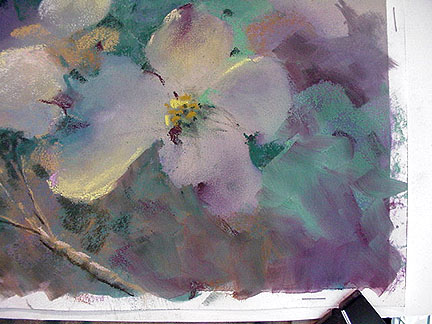How to Paint FlowersSoft Pastels With Alcohol Underpainting |
|||||||||||||||||
|
Underpaintings for pastels can be accomplished with several mediums depending on the support surface and its reaction to the medium. Watercolor and acrylics can be used if the support will take water mediums. Oils are acceptable for underpainting if thinned with turpentine or mineral spirits to produce a wash. Water can also be added directly to the first layer of pastels to create a wash technique. However, as a plein air painter, time is of the essence, and waiting for an underpainting to dry quickly can be frustrating! Discovering that household rubbing alcohol could be used to saturate the first layer of pastels and create a quick-drying underpainting seemed like a method to explore further! The Dogwoods painting for this article was created using alcohol spritzed over the surface to push the first layers of Nupastel into the tooth of the paper creating a soft background for the delicate white blossoms. 
Materials ListPastels - Hard pastels for the underpainting, soft pastels for the finish. I won't comment on color that much in this demo since the technique is the focus. Support - Test your paper with the alcohol to be sure it will not lift any sanded surface or create too much buckling. Spritzing does not wet the surface as much as painting the alcohol onto the surface with the brush. Alcohol - (I've used household rubbing alcohol-Isopropanol) You can also use denatured alcohol which can be purchased at paint stores. Spritz bottle Stencil brushes in varying sizes - Brushes come in all price ranges. The ones in the image to the right cost about $3 for the larger brush and $2 for the medium size brush. The bristles are slightly stiff and the top surface is very flat. You could also cut off an old brush until its surface was flat and could be used for scrubbing. Before beginning with the painting, let's take a brief look at how the alcohol reacts to the surface of the paper and how the underpainting will look. You could follow along with this brief demo and test your paper. You might find that you'll love the effect of an underpainting, especially for landscapes! I'm using the same Art Spectrum medium gray toned for my test that I'll be using for my painting. Choosing a couple of hard pastels and using the side of the stick, I lay down a swatch of color along the corner of the paper. Spritz with the alcohol and immediately use the large stencil brush flat against the surface to scrub the 'wet' pastel into the tooth of the paper. The images below show how much darker the paint looks when wet. When the pastel begins to dry, stop brushing, or spritz slightly in that area, and continue, until you have a nicely blended look. Since its an underpainting, you may not want to over blend - just spritz, and scrub! 



Using the Technique in a Painting
The support for this painting is Art Spectrum sanded surface paper, med gray/beige in tone, full sheet. When underpainting, you can begin with a white to light toned paper, but I chose this for the value. As you can see from the image, the flower petals appear very light compared to the background colors. With a lighter toned beginning, the contrast would have been more dramatic. I began with a rather loose sketch using vine charcoal. I liked the effect that the charcoal created interacting with the pastels as the painting progressed. Here, you will see that I've laid in a medium purple and a deeper purple establishing my values in the background. The light shines from the upper left so I want to create that effect immediately in the painting. You'll also see strokes of a vivid blue with the deeper purple. As I apply the alcohol and scrub it into the pastel, these colors will blend and create variation in the underpainting which later will become the basis for shapes! 
Since I've shown a brief demo of the scrubbing process, I'll include only a few tips for that. Working all over the painting, it took me about 20 minutes to spritz and scrub in my underpainting for the background. I could have used the colors all over the paper, but I chose to keeper blossoms unpainted. Using NuPastels on the side, I lay down the first layer using variation in the direction of strokes. I don't try to cover all of the paper. When wet, the pastel will spread easily. 
Here, you can see a dark smudged area below the petals. I have spritzed alcohol onto that area and scrubbed it into the tooth using my smaller stencil brush. You can see the effect while the pastel is wet compared to the still dry unsprayed areas beside the darker area. Spritz only the area that you can scrub in while the pastel is wet. Once the alcohol dries, the brush will lift the pastel instead of pushing it in! I like the effect of spritzing because I can work in smaller areas and use my brush to change the shape of the petals with negative painting. You could also dip your brush into the alcohol and scrub an area, but this method can become drippy. For an overall underpainting, dipping the brush and applying the alcohol more like a water wash, would be faster. 
Spritzed with alcohol....the darker areas also create a change of value. Watching this change of value can also give me new ideas about where to deepen my color! I wanted this to be a larger work, but after viewing my detail images, I think it might turn into a series of smaller works also! Don't you just love how a simple technique can generate so much creativity!! I'm using the larger brush here to underpaint some of the blossoms which will be on the shady side of the limb. 

After all of the first layer is spritzed and painted into the tooth, I decided to add a touch of blue/green to the underpainting. The image to the right shows the completed underpainting. Notice that many of the petals have been scrubbed over, too. Now I have a stronger pattern of dark and lights. I added some dots of color to the flower centers earlier since they will add to the sense of directing the eye through the painting. 

In the image above, I show how to reshape an area. I spritz lightly in the area I want to reshape and using the brush, pull the wet pastel down and out, then lift the brush. As you can see on the right, the petal shape has been changed and the center is lighter. The pastel which pools along the edge of the brush leaves a slightly darker area with more pastel pigment. Using this technique of "painting", I can reshape petals or pull out leaf shapes. You can also see that some of the charcoal line is still intact from my sketch. The alcohol tends to push the charcoal into the paper's tooth in the same way the pastel is pushed in. I didn't find that the charcoal presented a problem mixing with the pastels, but you could do your sketch with a NuPastel in one of your background colors. 
Time to paint without stopping to take photos! I'm looking for interesting shapes in the background and using spring colors to create the light butterflylike petals of the dogwood blossoms. Although dogwoods appear white, I use no white in the painting. Warm yellows, soft blue/greens, golden ochres are massed onto the underpainting allowing it to show thru. I also watch to keep the values close to the underpainting. Adding some touches of a lighter blue give the effect of the sky peeking thru from the background. Branches are added bringing the limb of blossoms more into focus and out of the background. 
After about an hour of painting, it's time to ask myself some questions. Have I kept my focal area interesting? Do I have an interesting path for the eye? Are there too many stars on the stage? Is the temperature of the painting too cool or too warm? Is there color harmony ? I'm constantly thinking about these things as I paint, but its good to take a step back at times for a more objective look. I also don't want to overwork this painting - the fresh abstract representational appeal of the dogwood blooms is what stirred my imagination to begin with and I don't want to lose that. 
One of the things I like to do is check my painting in black and white before I call it finished. Using my digital grayscale setting, I can view it thru the lens, but I'll post the image for all of you, too. One thing I notice is how the lower right corner is too light. I need a deeper value there to support the weight of the flowers above that corner. It's also too light to emphasize the branch extending up into the blossoms with the most focus. 
I add a darker green and deep purple to the corner, then decide that it comes forward too much. Spritzing to wet the pastel, I use the smaller brush with short side strokes and "paint" the area below the lower blossom and around the stem. This deepens the value in that area and pushes it into the background. The closeup shows the strokes. I don't blend this out smoothly. I want to keep the same abstract look to this area as the rest of the painting.  "Spring's Melody" I'll keep this sitting across the studio for a few days and then check it again for any other small touches that it might need before its framed, but for now, it's finished! If you have any questions about using alcohol to achieve an underpainting, please Join The Conversation which links to a thread in the Pastel Forum. I hope you've enjoyed the demo and will enjoy using this technique in your own paintings! By Carly Clements
|
|||||||||||||||||
Painting with Pastel
Art Lessons Online |








